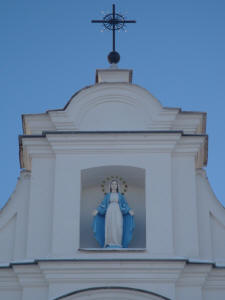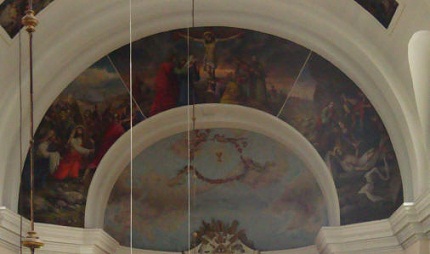The Daugavpils Roman Catholic Church of the Immaculate Conception of the Blessed Virgin Mary was founded as a facility of St Peter's Church of the city. Considering the on-going development of the city, it was decided not to expand the existing church in the centre of the city, but in contrary, to build a new church in the Jaunbūve district. The construction licence was received in 1902, but an independent parish was established in 1912.
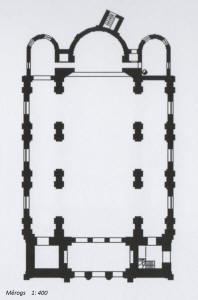
The church’s building was designed by an architect Wilhelm Neumann (Vilhelms Neimanis (according to his design, the Lutheran Cathedral (1891-1893) and the Grīva Catholic Church (1881-1889) were also built in the city. The construction works were administrated by a local engineer Jozafat Chłodziński (Jozafats Hludziņskis), but the performance of all “earth, masonry, plastering and carpentry works” was undertaken by Joseph Xavher Roschevsky (Josifs Ksavers Roščevskis). The construction of the church in the Jaunbūve District was initiated in mid-April of 1903. The church was constructed and consecrated in 1905.

The church is a plastered brick building. The two-tower facade of the church with slender towers is made in Neo-Baroque forms. The entrance is emphasized by a plastic portal design, but the attic of the profiled silhouette serves as a niche for the statue of the Mother of God.
This Roman Catholic Church is a monument of eclectic architecture. The common style includes the interior and exterior of the church. The space of the three-aisled basilica is divided by an arcade, but in the entrance hall is separated by glazed arches, above which an organ gallery has been built.
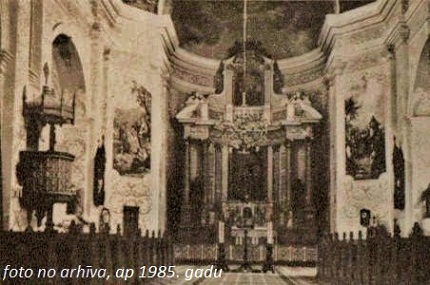
The middle aisle is covered with cylindrical vaults, but the side aisles are covered with cross vaults. The Chapel of Our Lady of Lourdes has been created in the church. The Neo-Baroque central altar, as well as the Neo-Gothic side altars, which are made of wood, were built during the period of 1905-1906. Neo-Gothic architectural forms are used for the pews, confessionals, as well as for the pulpit, which is decorated with openwork wrought iron. Luxurious, finely designed wrought iron railings are also designed for the organ gallery.
The copy of Bartolomé Esteban Murillio's painting “The Immaculate Conception of the Virgin”, made by Alexander Sergey Boravsky in St. Petersburg in 1906, is placed in the central altar.
The side altars contain paintings by anonymous professional authors of the first half of the 20th century, depicting St. Stanislaus and St. Casimir of Poland, while the author of the plot “Heart of Jesus” is artist J. Kosinski. Several plaster statues have also been used for interior decoration, but the terracotta reliefs portraying scenes of the “Way of the Cross” inscribed in wood-carved frames were brought from Poznań in 1905.
The church possesses the largest instrument in Latvia. It was produced by Polish organ builders, dated 1909 (28 ranks of pipes, two manuals), made by Adolf Homan (Warsaw, Vilnius); this idyllically sounding instrument was overhauled in 1984. The specialists included it in the category of Historical Organs of Latvia, but in 1986, the record company Melodija released a record containing compositions of this organ. The organ was exceptionally adapted to the original acoustics of the church.
In the second half of the 20th century (around 1978), the interior of the church was decorated with ornaments and mural paintings, the author of which is the local artist Albert Tirranen. The episodes of the life of the Mother of God are depicted in the semicircular frames on the middle walls, and the arch of triumph is devoted to the scenes of Christ’s life.
Our Catholic Church is a meaningful representation of sacral architecture arising from the epoch of Historicism, which has preserved its original form, vividly characterizing the regional peculiarities in the choice of prototypes (Baroque two-tower basilica), the correlation with the 18th century church architecture of the city, as well as revealing the artistic peculiarities of Wilhelm Neumann’s architectural style. (Vilhelms Neimanis).
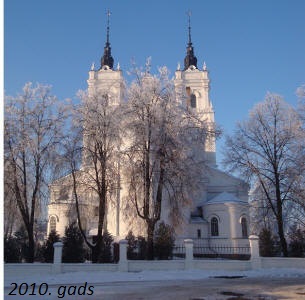 |
 |

